
Concept explainers
(a)
Interpretation:
The structure for the given IUPAC name is to be drawn.
Concept introduction:
The root name in the IUPAC name is the parent
Answer to Problem A.44P
The structure for the given IUPAC name is as follows:
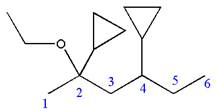
Explanation of Solution
The given IUPAC name is
The root name ‘hexane’ indicates the parent chain is of six carbon atoms.
Thus, the chain is numbered as shown below:
![]()
In the IUPAC name
Hence, the structure of
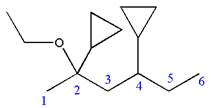
The structure for the given molecules is drawn from the root name, prefix and locator of substituent.
(b)
Interpretation:
The structure for the given IUPAC name is to be drawn.
Concept introduction:
The root name in the IUPAC name is the parent alkane. The longest continuous carbon chain must be drawn from the root name and numbered. The substituents are attached to the desired carbon number according to locator numbers given in the IUPAC name. The prefix indicates the number of identical substituents in the molecule.
Answer to Problem A.44P
The structure for
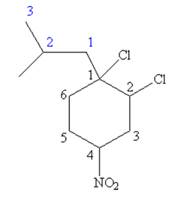
Explanation of Solution
The given IUPAC name is
The root name cyclohexane indicates the parent is a ring of six carbon atoms.

Hence, the structure of
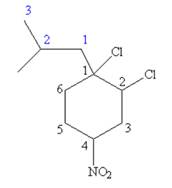
The structure for the given molecules is drawn from the root name, prefix and locator of substituent.
(c)
Interpretation:
The structure for the given IUPAC name is to be drawn.
Concept introduction:
The root name in the IUPAC name is the parent alkane. The longest continuous carbon chain must be drawn from the root name and numbered. The substituents are attached to the desired carbon number according to locator numbers given in the IUPAC name. The prefix indicates the number of identical substituents in the molecule.
Answer to Problem A.44P
The structure for the given IUPAC name is as follows:
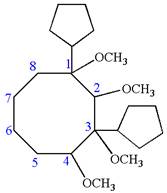
Explanation of Solution
The given IUPAC name is
The root name cyclooctane indicates the parent is a ring of eight carbon atoms.
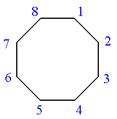
Hence, the structure of
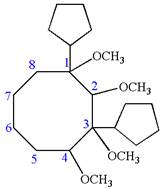
The structure for the given molecules is drawn from the root name, prefix and locator of substituent.
(d)
Interpretation:
The structure for the given IUPAC name is to be drawn.
Concept introduction:
The root name in the IUPAC name is the parent alkane. The longest continuous carbon chain must be drawn from the root name and numbered. The substituents are attached to the desired carbon number according to locator numbers given in the IUPAC name. The prefix indicates the number of identical substituents in the molecule.
Answer to Problem A.44P
The structure for the given IUPAC name is as follows:
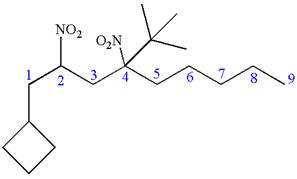
Explanation of Solution
The given IUPAC name is
The root name nonane indicates the parent is a chain of nine carbon atoms.
![]()
Hence, the structure of
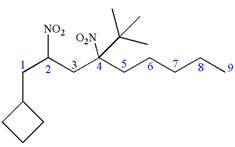
The structure for the given molecules is drawn from the root name, prefix and locator of substituent.
(e)
Interpretation:
The structure for the given IUPAC name is to be drawn.
Concept introduction:
The root name in the IUPAC name is the parent alkane. The longest continuous carbon chain must be drawn from the root name and numbered. The substituents are attached to the desired carbon number according to locator numbers given in the IUPAC name. The prefix indicates the number of identical substituents in the molecule.
Answer to Problem A.44P
The structure for the given IUPAC name is as follows:
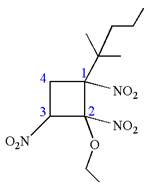
Explanation of Solution
The given IUPAC name is
The root name cyclobutane indicates the parent is a ring of four carbon atoms.

Hence, the structure of
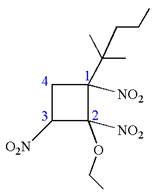
The structure for the given molecules is drawn from the root name, prefix and locator of substituents.
(f)
Interpretation:
The structure for the given IUPAC name is to be drawn.
Concept introduction:
The root name in the IUPAC name is the parent alkane. The longest continuous carbon chain must be drawn from the root name and numbered. The substituents are attached to the desired carbon number according to locator numbers given in the IUPAC name. The prefix indicates the number of identical substituents in the molecule.
Answer to Problem A.44P
The structure for the given IUPAC name is as follows:
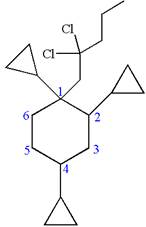
Explanation of Solution
The given IUPAC name is
The root name cyclohexane indicates the parent is a ring of six carbon atoms.

Hence, the structure of
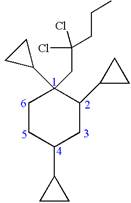
The structure for the given molecules is drawn from the root name, prefix and locator of substituent.
(g)
Interpretation:
The structure for the given IUPAC name is to be drawn.
Concept introduction:
The root name in the IUPAC name is the parent alkane. The longest continuous carbon chain must be drawn from the root name and numbered. The substituents are attached to the desired carbon number according to locator numbers given in the IUPAC name. The prefix indicates the number of identical substituents in the molecule.
Answer to Problem A.44P
The structure for the given IUPAC name is as follows:
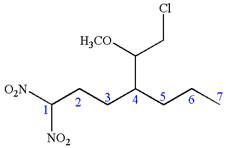
Explanation of Solution
The given IUPAC name is
The root name heptane indicates the parent is a chain of seven carbon atoms.
![]()

Hence, the structure of
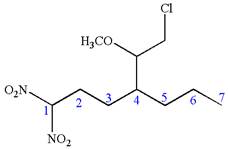
The structure for the given molecules is drawn from the root name, prefix and locator of substituent.
(h)
Interpretation:
The structure for the given IUPAC name is to be drawn.
Concept introduction:
The root name in the IUPAC name is the parent alkane. The longest continuous carbon chain must be drawn from the root name and numbered. The substituents are attached to the desired carbon number according to locator numbers given in the IUPAC name. The prefix indicates the number of identical substituents in the molecule.
Answer to Problem A.44P
The structure for the given IUPAC name is as follows:
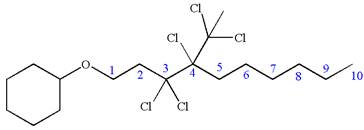
Explanation of Solution
The given IUPAC name is
The root name decane indicates the parent is a chain of ten carbon atoms.
![]()
Hence, the structure of
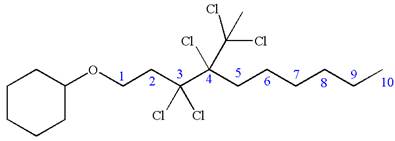
The structure for the given molecules is drawn from the root name, prefix and locator of substituent.
Want to see more full solutions like this?
Chapter A Solutions
Get Ready for Organic Chemistry
- In a reaction between two reactants A and B, the half-life is the same for both only if(A) the stoichiometry A:B is 1:1.(B) the stoichiometry A:B is 1:2 or 2:1.arrow_forwardIn a reaction between two reactants A and B, the half-life is the same for both.(1) Only if the stoichiometry A:B is 1:1.(2) If the initial quantities of A and B are in their stoichiometric ratios.arrow_forwardThere are 48 pairs of students in the following table. Each pair has quantitatively determined the mass of taurine in a 250 mL can of the popular energy drink marketed as “Munster” using High Performance Liquid Chromatography (HPLC). The class results are presented below: QUESTION: Calculate the measurement of uncertainty and provide the data in a spreadsheet table. Mass of Taurine (mg) Mass of Taurine (mg) (Table continued) 152.01 152.23 151.87 151.45 154.11 152.64 152.98 153.24 152.88 151.45 153.49 152.48 150.68 152.33 151.52 153.63 152.48 151.68 153.17 153.40 153.77 153.67 152.34 153.16 152.57 153.02 152.86 151.50 151.23 152.57 152.72 151.54 146.47 152.38 152.44 152.54 152.53 152.54 151.32 152.87 151.24 153.26 152.02 152.90 152.87 151.49 152.46 152.58arrow_forward
- 1. Predict the organic product(s) of the following reactions. Assume excess of reagents unless otherwise noted. a) &l BH3 •THF b) 1) NaOH 2) H3O+ solve d) ala 1) EtMgBr 2) H3O+ e) H2N سكر CuLi NH2 1) SOCI2 2) EtMgBr 3) H3O+ NC H3O+ Δarrow_forwardThere are 48 pairs of students in the following table. Each pair has quantitatively determined the mass of taurine in a 250 mL can of the popular energy drink marketed as “Munster” using High Performance Liquid Chromatography (HPLC). The class results are presented below: QUESTION: Summarise and report these results including an indication of measurement uncertainty. In both calculation samples calculate if an outlier is present, max value, number of samples, mean, standard deviation, g (suspect), g (critical) and t (critical). Mass of Taurine (mg) Mass of Taurine (mg) (Table continued) 152.01 152.23 151.87 151.45 154.11 152.64 152.98 153.24 152.88 151.45 153.49 152.48 150.68 152.33 151.52 153.63 152.48 151.68 153.17 153.40 153.77 153.67 152.34 153.16 152.57 153.02 152.86 151.50 151.23 152.57 152.72 151.54 146.47 152.38 152.44 152.54 152.53 152.54 151.32…arrow_forwardIndicate the rate expressions for reactions that have order 0, 1, and 2.arrow_forward
- PROBLEMS Q1) Label the following salts as either acidic, basic, or neutral a) Fe(NOx) c) AlBr b) NH.CH COO d) HCOON (1/2 mark each) e) Fes f) NaBr Q2) What is the pH of a 0.0750 M solution of sulphuric acid?arrow_forward8. Draw all the resonance forms for each of the fling molecules or ions, and indicate the major contributor in each case, or if they are equivalent (45) (2) -PH2 سمة مدarrow_forwardA J то گای ه +0 Also calculate the amount of starting materials chlorobenzaldehyde and p-chloroacetophenone required to prepare 400 mg of the given chalcone product 1, 3-bis(4-chlorophenyl)prop-2-en-1-one molar mass ok 1,3-bis(4-Chlorophenyl) prop-2-en-1-one = 277.1591m01 number of moles= 0.400/277.15 = 0.00144 moles 2 x 0.00 144=0.00288 moves arams of acetophenone = 0.00144 X 120.16 = 0.1739 0.1739x2=0.3469 grams of benzaldehyde = 0.00144X106.12=0.1539 0.1539x2 = 0.3069 Starting materials: 0.3469 Ox acetophenone, 0.3069 of benzaldehyde 3arrow_forward
- 1. Answer the questions about the following reaction: (a) Draw in the arrows that can be used make this reaction occur and draw in the product of substitution in this reaction. Be sure to include any relevant stereochemistry in the product structure. + SK F Br + (b) In which solvent would this reaction proceed the fastest (Circle one) Methanol Acetone (c) Imagine that you are working for a chemical company and it was your job to perform a similar reaction to the one above, with the exception of the S atom in this reaction being replaced by an O atom. During the reaction, you observe the formation of three separate molecules instead of the single molecule obtained above. What is the likeliest other products that are formed? Draw them in the box provided.arrow_forward3. For the reactions below, draw the arrows corresponding to the transformations and draw in the boxes the reactants or products as indicated. Note: Part A should have arrows drawn going from the reactants to the middle structure and the arrows on the middle structure that would yield the final structure. For part B, you will need to draw in the reactant before being able to draw the arrows corresponding to product formation. A. B. Rearrangement ΘΗarrow_forward2. Draw the arrows required to make the following reactions occur. Please ensure your arrows point from exactly where you want to exactly where you want. If it is unclear from where arrows start or where they end, only partial credit will be given. Note: You may need to draw in lone pairs before drawing the arrows. A. B. H-Br 人 C Θ CI H Cl Θ + Br Oarrow_forward
 ChemistryChemistryISBN:9781305957404Author:Steven S. Zumdahl, Susan A. Zumdahl, Donald J. DeCostePublisher:Cengage Learning
ChemistryChemistryISBN:9781305957404Author:Steven S. Zumdahl, Susan A. Zumdahl, Donald J. DeCostePublisher:Cengage Learning ChemistryChemistryISBN:9781259911156Author:Raymond Chang Dr., Jason Overby ProfessorPublisher:McGraw-Hill Education
ChemistryChemistryISBN:9781259911156Author:Raymond Chang Dr., Jason Overby ProfessorPublisher:McGraw-Hill Education Principles of Instrumental AnalysisChemistryISBN:9781305577213Author:Douglas A. Skoog, F. James Holler, Stanley R. CrouchPublisher:Cengage Learning
Principles of Instrumental AnalysisChemistryISBN:9781305577213Author:Douglas A. Skoog, F. James Holler, Stanley R. CrouchPublisher:Cengage Learning Organic ChemistryChemistryISBN:9780078021558Author:Janice Gorzynski Smith Dr.Publisher:McGraw-Hill Education
Organic ChemistryChemistryISBN:9780078021558Author:Janice Gorzynski Smith Dr.Publisher:McGraw-Hill Education Chemistry: Principles and ReactionsChemistryISBN:9781305079373Author:William L. Masterton, Cecile N. HurleyPublisher:Cengage Learning
Chemistry: Principles and ReactionsChemistryISBN:9781305079373Author:William L. Masterton, Cecile N. HurleyPublisher:Cengage Learning Elementary Principles of Chemical Processes, Bind...ChemistryISBN:9781118431221Author:Richard M. Felder, Ronald W. Rousseau, Lisa G. BullardPublisher:WILEY
Elementary Principles of Chemical Processes, Bind...ChemistryISBN:9781118431221Author:Richard M. Felder, Ronald W. Rousseau, Lisa G. BullardPublisher:WILEY





